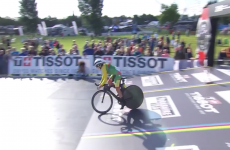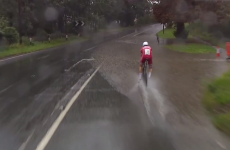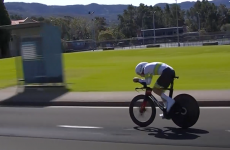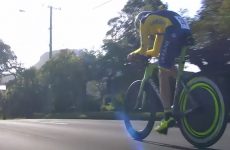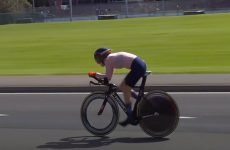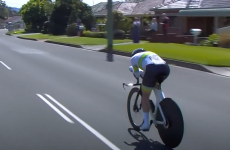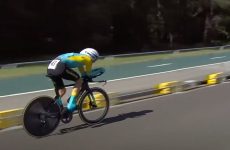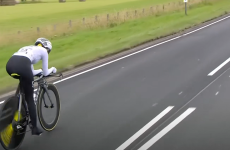Description
September 23, 2012
World Championships 2012 – Road Race – Maastricht – Valkenburg : 267,4 km
The Men’s Individual Road Race of the 2012 UCI Road World Championships cycling event took place on 23 September in the province of Limburg,
Show more...
September 23, 2012
World Championships 2012 – Road Race – Maastricht – Valkenburg : 267,4 km
The Men’s Individual Road Race of the 2012 UCI Road World Championships cycling event took place on 23 September in the province of Limburg, Netherlands. The race started in Maastricht and ended in Valkenburg. The first 108 kilometres (67 mi) was contested through a number of Limburg cities before the riders entered a 16.1 kilometres (10.0 mi) circuit to be completed on ten occasions. The finish was 1.7 kilometres (1.1 mi) beyond the summit of the Cauberg hill in Valkenburg – where the Amstel Gold Race had finished from 2003 to 2013, and hosted the finish of stage 3 of the 2006 Tour de France – a 1.5 kilometres (0.93 mi) long climb with a maximum gradient of 12%.
Philippe Gilbert (Belgium) pulled on cycling’s rainbow jersey with a perfectly-timed attack to win the 2012 world championships in Valkenburg, Holland. The Belgian attacked on the final ascent of the Cauberg, distancing a select group of pre-race favourites. Edvald Boasson Hagan (Norway) and Alejandro Valverde (Spain) rounded out the medals, while defending champion Mark Cavendish (Great Britain) abandoned after working for his team in the first half of the race.
The most decisive move of the race predictably came on the Cauberg, where Italy, through Luca Paolini, had looked to set up Vincenzo Nibali. The Italians’ effort, however, ran out of steam, with Gilbert attacking in the big ring as his rivals struggled on the climb’s punishing slope.
Although Alexandr Kolobnev (Russian Federation), Boasson Hagen and Valverde attempted to organise a chase they were unable to reel in the unstoppable Gilbert, who in the space of a matter of weeks has transformed his below-par season into a triumph.
“It’s hard to realize what happened. The Belgians did outstanding work. We deserved to win this title,” the winner said at the finish. “I was placed excellently [on the climb]. I looked back quickly and then took off. I still don’t realize that I am world champion.”
While Belgium celebrated its first rainbow jersey since Tom Boonen’s win in 2005, Valverde and Spain were left licking their wounds having proved the most aggressive team in the race. Their stellar line-up of stars initiated each major attack in the race but Valverde, who has now been on the podium four times, could only manage third.
Norway’s Boasson Hagen, who clipped away from Valverde inside the final 500 meters, praised both his teammates and the eventual winner. “It was very good to get second place, but we were close to gold,” said Boasson Hagen. “Gabba (Gabriel Rasch, ed.) and Lars Petter (Nordhaug) rode well and did a great job. I am very grateful. Gilbert was very strong and there was nothing I could do.”
Early encounters
After a week of racing the 2012 world championship’s final event began almost as if the 2011 race had never ended: with Mark Cavendish and his Great Britain team controlling the peloton in the early stages. Wearing dossard number 1, Cavendish had ruled himself out of an ever-expanding list of favourites due to the climbing incorporated in this year’s race. The 267km course featured a 105km jaunt through southern Limburg before tackling ten laps of the now familiar circuit course with the infamous Cauberg’s crest situated 1.7 kilometres from the finish.
Although early attacks rained down, it was Great Britain who marshalled the peloton. Cavendish, along with Alex Dowsett, eventually allowed a group of Pablo Lastras (Spain), Dario Cataldo (Italy), Timothy Duggan and Alex Howes (USA), Jerome Coppel (France), Winner Anacona (Colombia), Luka Mezgec (Slovenia), Vladimir Isaichev (Russia), Vitaliy Buts (Ukraine), Fabricio Ferrari (Uruguay) and Gatis Smukulis (Latvia) to escape but the defending nation continued their pace setting, despite the pressure being on the shoulders of the home nation.
By the time the race came to life and reached the Cauberg for the first time the gap was at a steady 3:28. It was there that the Spanish played their first of many cards. Despite an earlier crash for Oscar Freire, the Armada looked an impregnable team of guile and diversity. The only question appeared to be whether they had too many leaders. But it was one of their most reliable workhorses in Juan Antonio Flecha who lit the fuse, sparking a move that included Stephen Cummings (Great Britain) Rinaldo Nocentini (Italy), Gianni Meersman (Belgium), Michael Matthews (Australia), Maxime Bouet (France),Michael Schär (Switzerland), Fumiyuki Beppu (Japan), and Jakob Fuglsang (Denmark).
It sparked a reaction from Belgium – with their two leaders in Gilbert and Boonen – sheltered behind a line of blue jersey. The increase in pace saw Cavendish retire but just as one world champion pulled out, one candidate for today’s victory, Alberto Contador, attacked.
The Spaniard used the Cauberg to ignite panic in the bunch, with Robert Gesink and Thomas Voeckler among a handful of riders who were able to keep pace.
Merging powers
Eventually Flecha’s group caught the leaders, before Contador and his collaborators joined too. It created a group of nearly thirty riders with Pablo Lastras, Alberto Contador and Juan Antonio Flecha (Spain), Dario Cataldo, Rinaldo Nocentini, Marco Marcato and Diego Ulissi (Italy), Timothy Duggan and Alex Howes (USA), Jerome Coppel, Maxime Bouet and Thomas Voeckler (France), Winner Anacona (Colombia), Luka Mezgec (Slovenia), Vladimir Isaichev (Russia), Vitaliy Buts (Ukraine), Fabricio Ferrari (Uruguay), Gatis Smukulis (Latvia),Stephen Cummings and Jon Tiernan-Locke (Great Britain), Gianni Meersman and Bjorn Leukemans (Belgium), Michael Matthews (Australia), Michael Schär and Michael Albasini (Switzerland), Fumiyuki Beppu (Japan), Jakob Fuglsang (Denmark) plus the host nation’s Koen De Kort and Robert Gesink (Netherlands).
Despite each nation having two riders in the break, Belgium joined forces with the Dutch at the head of the peloton in limiting the danger to a minute. The Spanish, with Flecha and Lastras, and the French, berated into working by Voeckler, continued to push at the head of affairs but with so many stragglers and riders unwilling to work the move was always doomed.
Lastras and Bouet were used up on the 7th lap of the Cauberg but a crash in the peloton split the field. It ended a number of riders’ chances, saw Peter Sagan lose almost his entire team and reduced the bunch to 57 riders.
As the break neared two laps to go Flecha continued his work on the front but by now the escape was only 36 seconds clear. An attack from Fabian Wegmann (Germany) drew the leaders ever closer and saw a number of the early escapees even caught. By the time they crested the Cauberg and reached the finish line the escape had been neutralised.
But a definitive selection had yet to be made as unlike Valkenburg’s 1998 Worlds, when the skies opened up and made the race, this year’s light showers had no such effect with approximately 70 riders still in contention.
Andrew Talansky (USA) attempted to make sure his team’s earlier work wasn’t lost in vain and attacked on the Bemelerberg and when Ian Stannard (Great Britain) lurched across it looked as though the favourites could use the tandem as a spring board.
A combination of tired legs and a headwind scrapped any chance and on the penultimate ascent of the Cauberg tactics gave way to frustration. Vincenzo Nibali (Italy) attacked but his accelerations were shut down almost immediately, the soon to be Astana rider gesticulating for others to help him make the race more aggressive.
With Talansky and then Stannard caught, the race headed for the final lap, with a firm realisation that if the final climb up the Cauberg could not split the field then a sprint finish would decide this year’s race.
Inside the final 10 kilometres positioning became paramount. Spain moved Valverde and Rodriguez near the head of the field, as Belgium, Italy, and the outgunned Norway did the same. Alberto Contador and Samuel Sanchez took two long pulls on the front before Luca Paolini took charge, leading the peloton on the lower slopes of the Cauberg.
Moments before it had been Nibali who set the pace on the approach, a tactic that cost the Italian as he ran out of gas on the climb. At one point, with four Belgians on the Italian’s rear wheel, it looked as though a clean sweep could occur but Gilbert’s aggression and turn of speed was too much.
Results :











